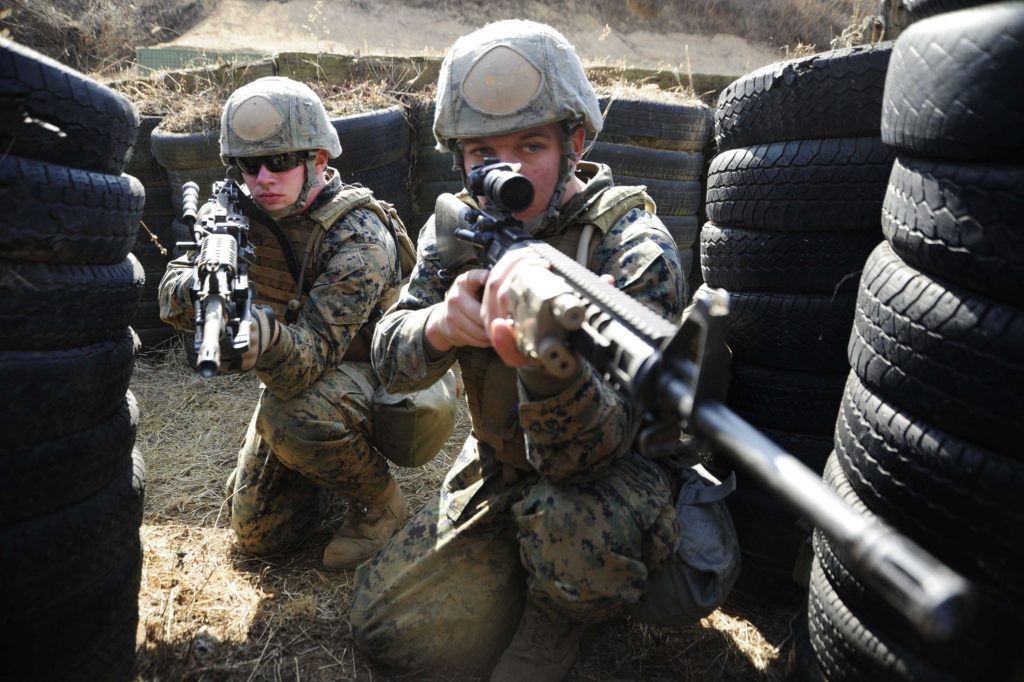The Peninsula
Are U.S.-ROK Military Exercises Unnecessary Provocations?

By Mark Tokola
Reasonable people, especially people new to looking at policy on the Korean Peninsula, might wonder if the North Koreans may have a valid point when they complain that U.S.-ROK joint military exercises are unnecessarily provocative. If the goal is to engage in constructive diplomacy, wouldn’t it be a good first step for the Americans and South Koreans to stop practicing for war? Well, not really. The issue of military exercises on the peninsula has a long history and it is worth recalling that the U.S. and ROK did suspend exercises from 1994 to 1996 to try to help create a positive atmosphere for diplomacy, without much effect. It is also worth recalling that North Korea conducts annual military exercises of its own which it has never offered to suspend.
In general, the U.S.-ROK military exercises are as regular as clockwork, are well understood by North Korea, and serve useful purposes. The annual exercises are matched by annual expressions of displeasure by the North Korean government. It is all quite predictable, even stabilizing. The cycle is so routine that one American news headline stated that the joint exercises that had not yet begun “will be met by North Korean outrage.” After twenty-five years of North Korean protests and threats, analysts look for nuances within the North Korean ritualistic protests rather than being concerned that the threats are being made at all.
Military exercises are necessary for testing what happens when military plans are put into effect. Although they cannot reproduce combat conditions, they test equipment, communications, logistics, and force integration in ways that cannot be duplicated in table top exercises or computer simulations. All militaries exercise, including North Korea’s. Far from being provocative, exercises can lead to increased stability because they reduce the temptation to guess an opponent’s capabilities and resolve. Military miscalculations are more likely to occur in an environment in which an opponent is overestimated or underestimated than one in which military exercises routinely are held in plain view. During the Cold War, NATO and Warsaw Pact exercises were carried out in full view of each other, reducing uncertainties.
The annual Foal Eagle/Key Resolve exercises conducted by the U.S. and South Korea test the ability of their joint Combined Forces Command to defend South Korea. They are considerably more modest in scope than the “Team Spirit” exercises which preceded them until 1997. The exercises test movement of military assets, security and stability operations, ground maneuver, combat air operations and maritime group operations in ways that are clearly visible to North Korea as defensive in nature. They are conducted in as unthreatening a manner as possible. The North Korean government is notified in advance of the exercises and the United Nations Command specifically reassures the North Korean People’s Army at general officer-level talks in advance of the exercises that they have no connection to current political developments. Extraordinarily for military exercises, the U.S.-ROK joint exercises are monitored by the UN’s Neutral Nations Supervisory Commission to ensure that they in no way violate the Korean Armistice Agreement. The value of the military exercises conducted in South Korea is evidenced by the participation in recent years of an increasing number of countries, members of the United Nations Command structure that is tasked with enforcing the armistice. Observers and forces from Australia, Canada, Denmark, Norway and UK have participated since 2011.
North Korea clearly wishes the annual joint military exercises to stop, in part because they hope it would signal to the South Korean public a diminution of the U.S.-ROK alliance. It is revealing that North Korea has never proposed a halt to the exercises as part of a balanced, diplomatic initiative that would involve a cessation of their own exercises. To the contrary, the peak of North Korea’s efforts to force an end to the exercises came in 2011, following North Korea’s sinking of the ROKS Cheonan and the shelling of Yeonpyeong Island that resulted in South Korean civilian deaths. In early 2011, North Korea, clearly hoping that the increased tension on the peninsula as a result of its own actions would lead the U.S. and ROK to make concessions, threatened that if the annual exercises were held, the consequence would be a “merciless counteraction engulfing Seoul in a sea of flames.” The ROK and U.S. refused to be intimidated by the threats and held the exercises as always.
It is not unimaginable that the annual joint military exercises could be an element in a future comprehensive negotiation with North Korea, but given their contribution to military readiness and political stability, and their long-standing nature, there is no reason to unilaterally put them to an end. To do so would be less a good will gesture than the introduction of a new element of uncertainty in a region that already has too many uncertainties.
Mark Tokola is the Vice President of the Korea Economic Institute of America. The views expressed here are his own.
Photo from U.S. Pacific Fleet’s photostream on flickr Creative Commons.
